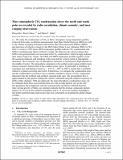Mars atmospheric CO2 condensation above the north and south poles as revealed by radio occultation, climate sounder, and laser ranging observations
Author(s)
Cahoy, Kerri; Zuber, Maria; Hu, R. Y.
DownloadMain article (6.625Mb)
Metadata
Show full item recordAbstract
We study the condensation of CO2 in Mars' atmosphere using temperature profiles retrieved from radio occultation measurements from Mars Global Surveyor (MGS) as well as the climate sounding instrument onboard the Mars Reconnaissance Orbiter (MRO), and detection of reflective clouds by the MGS Mars Orbiter Laser Altimeter (MOLA). We find 11 events in 1999 where MGS temperature profiles indicate CO2 condensation and MOLA simultaneously detects reflective clouds. We thus provide causal evidence that MOLA non-ground returns are associated with CO2 condensation, which strongly indicates their nature being CO2 clouds. The MGS and MRO temperature profiles together reveal the seasonal expansion and shrinking of the area and the vertical extent of atmospheric saturation. The occurrence rate of atmospheric saturation is maximized at high latitudes in the middle of winter. The atmospheric saturation in the northern polar region exhibits more intense seasonal variation than in the southern polar region. In particular, a shrinking of saturation area and thickness from LS similar to 270 degrees to similar to 300 degrees in 2007 is found; this is probably related to a planet-encircling dust storm. Furthermore, we integrate the condensation area and the condensation occurrence rate to estimate cumulative masses of CO2 condensates deposited onto the northern and southern seasonal polar caps. The precipitation flux is approximated by the particle settling flux which is estimated using the impulse responses of MOLA filter channels. With our approach, the total atmospheric condensation mass can be estimated from these observational data sets with average particle size as the only free parameter. By comparison with the seasonal polar cap masses inferred from the time-varying gravity of Mars, our estimates indicate that the average condensate particle radius is 8-22 mu m in the northern hemisphere and 4-13 mu m in the southern hemisphere. Our multi-instrument data analysis provides new constraints on modeling the global climate of Mars.
Date issued
2012-07-10Department
Space Telecommunications Astronomy and Radiation (STAR) Lab; Massachusetts Institute of Technology. Department of Aeronautics and AstronauticsPublisher
Journal Of Geophysical Research-Planets
Citation
Hu, R., Cahoy, K., & Zuber, M. (n.d). Mars atmospheric CO2 condensation above the north and south poles as revealed by radio occultation, climate sounder, and laser ranging observations. Journal Of Geophysical Research-Planets, 117
ISSN
01480227
Keywords
MARTIAN POLAR CAPS, GENERAL-CIRCULATION MODEL, CARBON-DIOXIDE CLOUDS, GLOBAL SURVEYOR, SEASONAL CAP, ICE CLOUDS, ALTIMETER, TES, TEMPERATURES, PRESSURE